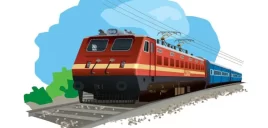A Locking Table is a table that gives the complete set of interlocking relationships among signal and point levers in a cabin. A Pull Sheeet is similar, in that it conveys the same information, but is geared towards the lever operator’s convenience in showing which other levers need to be pulled for any lever. A sample locking table is shown below.
| Lever No. |
Releases |
Requires |
Locks normal |
Locks both ways |
| 1 |
|
2, 3 |
|
|
| 2 |
1 |
3 or 4 |
|
|
| 3 |
1,2 |
5,8 |
7,6 |
|
| 4 |
2 |
6,5,8 |
7 |
|
| 5 |
3,4 |
|
|
6 |
| 6 |
4 |
|
3 |
|
| 7 |
|
8 |
3,4,13,18,19 |
|
| 8 |
3,4,15,18,19
16 with 13 reverse |
|
|
|
| 9-12 |
Spare |
| 13 |
15 |
|
7,18,19 |
|
| 14 |
15 |
|
|
13 |
| 15 |
|
8,13,14 |
|
|
| 16 |
|
14,
8 with 13 reverse |
19 |
|
| 17 |
20 |
|
|
7,13 |
| 18 |
20 |
8 |
7,13 |
|
| 19 |
20 |
8 |
7,13,16 |
|
| 20 |
|
17,18,19 |
|
|
This example (from Introduction to Railway Operation, by Francis Da Costa) shows the locking table for a signal frame (in cabin ‘A’ at a station with two cabins, ‘A’ and ‘B’) which has 20 levers: 7 signal levers, 3 slot levers, 3 point levers, 2 point locks, and one 1 gate lock, along with 4 spare levers. The column marked ‘Requires’ shows which levers have to be pulled first before pulling any given lever. (This column by itself forms the Pull Sheet.) The ‘Releases’ column indicates which levers are released by pulling a given lever.
Lever 1 operates the Warner – before this is taken off, the main Home and Outer have to be taken off. Hence 1 requires 2 and 3.
Lever 4 is for the Loop Home. To take it off, the route has to be set and locked for the loop (6 and 5) and the gate must be closed (8). Pulling 4 in turn releases lever 2 for the Outer signal. The cross-over lever 7 is locked in normal position to avoid conflicting movements.
Lever 19 is the slot lever for the ‘B’ cabin main home signal. PUlling it releases the slot (20) for ‘B’ cabin’s warner. Lever 8 for the gate is required because the level crossing must be closed before pulling 19. To avoid conflicting movements, lever 13 for the facing points, and lever 7 for the cross-over points are locked in normal position.
Cabin Arrangements
There are a few different ways that cabins can be set up for a station. Normally for a Standard III station, there are two cabins, one at either side of the station. Each cabin controls the points and signals on its side. In one common arrangement (more common in the past when relatively less experienced staff – cabinmen or levermen – were posted to the cabins), the block instruments are kept at the Station Master’s office, and the Station Master has control over the reception and departure signals (Home and Advanced Starter). The signal levers for taking these signals off and for setting the points appropriately operate only when the Station Master permits, either by direct electrical interlocking from the block instrument to the signal frames, or by keys dispensed by the Station Master. Keys may be dispensed by instruments such as the Hepper’s Key Instrument, electric Slide Instrument, or Interlocked Key Box, which are electrically interlocked with the block instruments. A later practice – still commonly seen – was to locate the block instruments in each cabin, while the signals can be controlled from the Station Master’s office. However, in cases where double-wire transmission is provided, the tendency is to keep the block instruments at the stations and not at the cabins and have more control over the signals and points from there.
Inter-cabin control: Signals and points are slotted as explained above between the cabins to coordinate their operation. For instance, for one cabin to take off the Home signal, the line has to be clear for an adequate distance beyond the Starter or trailing points, which can only be verified by the other cabin. In other cases, setting a route for the main line or loop line by one cabin is not possible without the other cabin verifying that the line is free of obstructions or that an appropriate siding is available.
Two cabins or one: Especially with double-wire transmission, all signals and points can in many cases be controlled from one central location. Having one central cabin can save on equipment and staff. However, there are some benefits to having cabins at either side of the station. One advantage is that the cabin staff on either side can check that trains are arriving intact, verifying that trains have cleared the fouling mark (this may be the duty of the guard as well), controlling level crossing gates near them, etc. More eyes watching also means that problems like hot axles or dragging equipment are more likely to be caught. Another consideration is that shunting operations can proceed slowly as all movements have to be coordinated with the single cabin and the guards and drivers of various trains, whereas with two cabins the cabin staff at either end can manage shunting operations at their ends independently. Finally, note that when the signals and points are far, generally speaking keys have to be dispensed by the Station Master for operating them; passing the keys back and forth takes time. (This can be alleviated by electrical interlocking.)
Electrical Interlocking
Electrical equipment of some kinds may be used even in the mechanical interlocking systems described above (e.g., electrical relays that operate slotting). However, the basic operation there remains mechanical in nature. In electrical interlocking, the fundamental mechanisms use electric control extensively. Electrical interlocking often goes hand in hand with power signalling, although there are or were installations with electrical interlocking provided for semaphore signals.
Relays
Relays of various sorts are used to turn on or turn off circuits that control signals, points, slots, level crossing gates, etc. Track relays are used for track circuits (see below). Signal relays control signals.
Track Circuits
Track circuits are electrical circuits that are formed including the running rails. They are set up in such a way that when a train is on the tracks that are part of the track circuit, the circuit is altered in some way (usually, by current that normally flows in the track circuit being shunted through the conductive body of the train), thereby activating a detector which may then be used, e.g., to set signals at danger for the section.
Track circuits help with interlocked operation as they allow signals to be pulled off only if the section of track they control is safely clear of any vehicles. They also remove the human element of needing to scrutinize the track for the presence of trains that may be out of view of the signalling staff or cabinmen.
Track-circuiting is mandatory in sections where visibility is a problem, shunting operations are routinely carried out on the block section outside station limits on the main running line, or if special situations exist, e.g., if the advanced starter is more than one full train-length ahead of the most advanced trailing points of the station.
Axle Counters
Axle counters are devices that can count the number of axles of vehicles passing by them on the track. Axle counters are installed at either end of the section of track of interest; when the number of axles counted at entrance to the section is the same as the number of axles counted exiting the section, it means the train has passed through the section intact. Axle counters are used in some cases where track circuits are hard or impossible to operate (e.g., where metal sleepers are provided, making track circuit operation impossible without re-installing the track, or where conditions are such that there is too much electrical noise and conductivity problems that make track circuits unworkable).
Source – IFRCA.org
This entry was posted in 2 Railway Employee, STUDY NEW, Railway Employee










